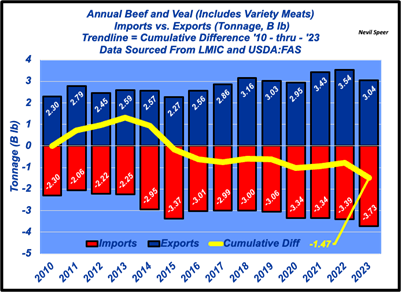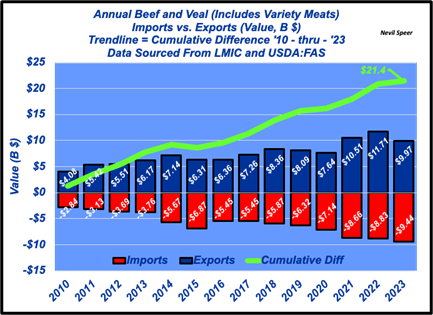Speer: Protectionists Make Bad Bookkeepers

Disclaimer: None of what follows is related to Paraguay, specifically (micro). Rather, it’s intended to provide a broader understanding of international trade (macro). Why this column now? One, the importance of international trade can never be over-emphasized (for more see the white paper authored by Drs. Peel and Tonsor). Two, the Paraguayan situation has been overtly politicized regarding the attributes of trade.
Smoking Gun: RCALF is now declaring that, “USDA trade policies hurt ranchers.”
The ranch group believes they found the smoking gun. They plucked the economic breakdown from USDA’s Paraguayan overview and extrapolated it to the entire trade complex. The Federal Register analysis reads as follows: “…consumer gains of $14 million to $27 million would outweigh producer losses of $12 million to $24 million, yielding annual net social welfare gains of $1.6 million to $3 million.”
If you’re a producer, and focus on just that tidbit, it all sounds ominous. Overall social good comes at your expense – net cost of Paraguayan beef imports would damage the industry to the tune of ~$18M annually. RCALF then plays on that theme and further explains that producers also got duped by allowing imports from Brazil and Argentina. As a result, “…these hundreds of millions of dollars in economic injury inflicted on America’s ranchers by the USDA’s trade policies have contributed greatly to what we learned in the 2022 census – and that is that during each of the past five years, on average more than 21,000 American ranchers have quit ranching, with a total loss of ranchers of 107,000 during that short period.”
Critical Thinking: All that rhetoric requires a little unpacking. If we’re objective, the analysis was likely premised on the assumption imported beef is a final product – versus an intermediate product (none of this is clear in the explanation). Why does that matter? Doug Irwin, in his great book, Clashing Over Commerce, explains the distinction this way: “…not all imports of manufactured goods are direct substitutes for domestic production: imports may be so different from domestically produced goods that they do not really compete with one another.”
That’s an important distinction. The majority of beef imports are lean trimmings for the purpose of being blended with 50/50 trim. Dr. Peel recently underscored the importance of imports to the domestic industry: “The major portion of U.S. beef imports is lean beef used for the ground beef market.”
IF-THEN: But never mind all that, let’s just take RCALF’s assessment (trade policies hurt ranchers) at face value – and imports are solely responsible for ranchers exiting the business. Therein enters the yin-and-yang of trade.
IF we’re intellectually honest, THEN we must also conclude this about trade: IF imports hinder producers, THEN (equally and oppositely) exports benefit producers. See, RCALF declares trade detrimental but highlights only the debit side of bookkeeping and conveniently avoids the credit side of the ledger.
Data: But never mind all that, let’s turn to the data (versus hyperbole). Let’s break it up in two parts. First, tonnage, and then second, dollars.
- The first graph outlines annual import and export tonnage – along with the cumulative total since 2010. The net difference over the past fourteen years totals ~1.47 B lb – or roughly 105 M lb annually. For some perspective, consider that annual beef production during that time averaged 26.27 B lb. In other words, the import / export discrepancy represents only four-tenths-of-one-percent (.4%) versus domestic production.

- The second graph is what really matters! During the past fourteen years, exports have outrun imports by nearly $21.5 B! Clearly, beef producers are winning in the global marketplace.

Protectionists Flawed Bookkeeping: Turns out, protectionists make bad bookkeepers – they only record the debits. No wonder they’re so glum about it all. Of course, the one-sided approach also avoids acknowledging the success of the Checkoff in building international markets over time. (It reminds me of one of the great lines from Casablanca: “We hear very little and understand even less.”)
To get the full accounting, the credits also have to be recorded. And those books tell a very different story. America’s ranchers are the direct beneficiaries of international trade.
Nevil Speer is an independent consultant based in Bowling Green, KY. The views and opinions expressed herein do not reflect, nor are associated with in any manner, any client or business relationship. He can be reached at nevil.speer@turkeytrack.biz.







